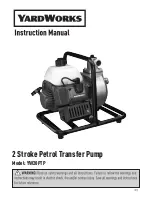
Commissioning
• Close the flow meter fill/drain valve (1) and increase pressure in the system to the maximum design pressure, 145 psi (10 bar), using the external
filling pump connected to the safety unit fill/drain cock. When this pressure is reached (2), close the safety unit fill/drain valve using the control lever.
• Open the valves under the temperature gauges (3) and switch on the solar circulation unit pump.
• Allow the water to circulate for a while and then check for leaks.
• Re-open the air vent installed at the highest point of the solar thermal system and repeat the air purging procedure, briefly activating the circulation
pump.
• Restore the desired working pressure with the filling pump.
• The flow rate of the system can be varied using the flow meter (4). This modulation is performed by the ball valve with which it is equipped (see
respective characteristics). Follow the solar panel manufacturer's flow rate recommendations when setting the flow rate.
• After the first few operating hours, the solar thermal system must be purged of excess air again, both in the highest point and on the air separator
(if equipped).
Once the air is purged, check system pressure and if necessary restore to the desired working pressure.
Draining the system
• Draining is necessary if the system has been filled with water only and there is a risk of frost.
• Open the shut-off and check valves (under the temperature gauges), turning them 45°. Open the air vents at the highest point.
• Open the drain valve at the lowest point of the system.
Flushing the system
•
Close the flow meter adjustment ball valve (1). and open the fill/drain valve (2).
• Connect an external (separate) pump to the safety relieve valve fill/drain valve (3), allow the medium to flow through the solar panels and the heat
exchange circuit until it flows out of the flow meter fill/drain valve (4).
• Briefly open the flow meter ball valve (4) to expel all air from the system.
• Leave the external pump running on the system for a few minutes to ensure correct flushing.
1
6
7
1
2
2
3
4
3
4


























